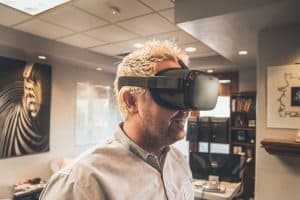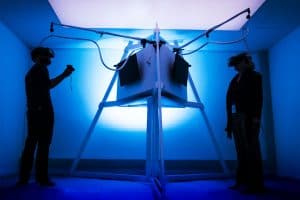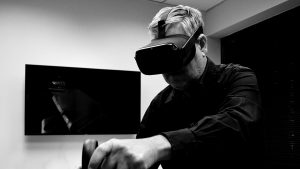Transform Business Collaboration Using Virtual Reality Technology
What is virtual reality training?
Virtual reality has grown in popularity in recent years. As of 2018, there are over 171 million active virtual reality users across platforms like Oculus, Vive, Hololens and Playstation VR. While virtual reality is commonly known as a vehicle for consumer entertainment apps like Beat Saber, Youtube VR, and Netflix VR, the technology presents a myriad of opportunities for companies worldwide. One area that is showing promise is virtual reality training.
Virtual reality (VR) training digitally simulates scenarios for training purposes. Virtual reality offers a risk-free simulated environment with repeatable training exercises. A user enters a 360 degree interactive environment to participate in active learning. Using the headset and pair of controllers, users can move about the environment freely with the ability to interact with objects, avatars, tools, and much more. Within a virtual environment, users can follow a step-by-step process to accomplish certain goals or assignments; similar to a real world training exercise.
While virtual reality (VR) may not necessarily replace your current educational modules, it offers companies a hybrid curriculum that could vastly improve user efficiency and performance. In the workplace, scenarios that were once too difficult or too dangerous to train for become much more practical, cost-effective, and safe. At Invonto, we developed a realistic laboratory VR simulation to help our client’s stakeholders better understand the construction project floor plans. By moving within the environment, they were able to provide critical feedback that saved them rework and unnecessary expenditures. Virtual reality training can significantly improve learning retention, job performance, team collaboration, and workplace safety.
Because we learn best by doing, a combination of immersive scenarios and engaging story narratives make virtual reality training a top investment for innovative businesses.
How effective is virtual reality training?
From military training to surgical training and education, virtual reality training is being used throughout the world. Still, there are many that are not entirely sold on the concept. Virtual reality training’s effectiveness is dependent on the quality of the training itself. Typically, the training should include realistic environment, simulated workflow, repetition, contextualized scenarios, and critical feedback. Virtual reality training also offers additional benefits that may not be apparent.
Removing Unnecessary Risks
Virtual reality training allows trainees to practice procedures that may not be safe in the real world. This is extremely applicable in multiple industries including healthcare, construction, military, and industrial engineering. Employers can easily run different scenarios in VR safety training exercises without endangering employees, customers, or the environment. Employees can participate in training scenarios with minimized stress allowing them to focus on the task at hand.
Faster Training
Because companies will question the effectiveness of traditional training methods, most U.S. employees don’t participate in any on-site training at all. Employees are often flung into tasks without any proper training and must “learn by doing” on the job. This can not only be dangerous for employees, but could negatively impact your overall brand. With virtual reality training, employees can be trained up to four times faster than using traditional methods. The decrease in training times may encourage employers to invest in their employees which will only serve to improve the customer experience.
Providing Effective Feedback
Virtual reality training can also improve the way employers deliver feedback to employees. Prompts can be programmed into the application to help guide employees through their training. Rather than fumble through awkward critiques with employees, the virtual reality application can deliver the majority of feedback. Additionally, each session can be saved to provide additional analytics giving employers even greater insight into the effectiveness of the training. As the virtual reality training takes place in a digital environment, all employees receive same level of training without any discrimination or bias.
Immersion For More Focused Training
Virtual reality’s ability to create a highly immersive experience makes it one of the most effective teaching methods available. Wearing the virtual reality headset blocks out all external distractions. Users are encouraged to focus only on what they can see and hear. Because users are more focused, users’ learning retention vastly improves. Virtual reality training makes it easy to repeat training exercises without incurring additional costs. This helps users become more proficient at a task.
What are the benefits of virtual reality training?
Virtual reality is an incredibly effective training method. The technology provides many benefits to the businesses who invest in it.
Virtual Reality Improves Job Performance
Studies prove that employee job performance increases when utilizing virtual reality training. Because virtual reality removes many of the risks and distractions commonly found in traditional training methods, employees are more likely to retain information and outperform those who do not use virtual reality training. Employees also build more confidence as they have to worry less about performing a task in a virtual environment then in a real environment. Everyone has a different learning style and VR training offers flexibility users require to undergo a training exercise. Virtual reality training makes it easy for employees to experiment with new processes and systems before implementing them in the actual business practice leading to continuous innovation in the workplace.
Virtual Reality Is Cost Effective
In the past, virtual reality was very expensive. However, platforms like Oculus, Pico, and Hololens are making the virtual reality and mixed reality hardware easily accessible. Investing in virtual reality training now means greater long-term savings in the future. If your training is more effective, less time is spent retraining employees on procedures. In addition to less time spent training, you will also need less resources to run sessions. Since everything is virtual, training sessions don’t require any of the additional hardware, equipment, tools, or clothing that is commonly used to immerse a user. By saving on time and resources, employers interested in more effective training should have no issues justifying the cost of virtual reality (VR) applications. VR makes it easy to scale and expand training programs. As businesses and their training needs evolve, it is more cost-effective to update VR training solutions than updating physical training spaces and procedures. This makes VR a powerful tool that companies can use for upskilling their workforce.
Virtual Reality Makes Training Accessible
In situations where employees and customers are remote, it is often not feasible to bring them together for in-person demonstrations, training, or collaboration. VR makes it easier for delivering training solutions for remote users. All a user needs is a VR headset! This makes VR one of the most accessible and powerful training solutions. VR training also makes it easier for a team-based and collaborative training regardless of where each person is. This saves organizations a lot of time and costs from not having to colocate their employees and customers as well as not requiring physical spaces for the training.
Virtual Reality Leads To Earnings
Whether your goal is to reduce costs or increase revenue, virtual reality training can play a large part in your overall business strategy. Employers can expect greater performance from employees that will pay dividends both internally and externally. Internally, employers should use training to identify bottlenecks in workflows and take advantage of these insights to improve them. Employers should feel more confident and perform more efficiently with continual virtual reality training support. Externally, the increase in performance in both hard and soft skills should be felt by your customer base. These elements combined will improve the business overall and lead to increased revenue.
Conclusion
Companies can build VR training solutions for almost all aspects of their work related training. Whether creating a VR training for heart surgery in healthcare, scientific research in pharmaceutical, safety training in construction, or war zone exercises in the military; VR training can help companies transform their workplace training. Through virtual reality training, employees will be more engaged, better prepared, and develop new skills faster. Creating VR training applications can help companies save costs, offer safer training environment, and improve workplace collaboration. At Invonto, we develop enterprise virtual reality applications built to meet your overall business objectives. One of the most commonly requested applications of virtual reality is training. We strongly believe in the effectiveness of VR training and are excited to see how the technology develops overtime. Interested in exploring the benefits of VR training for your company? Contact us today for scheduling a call with our team.



